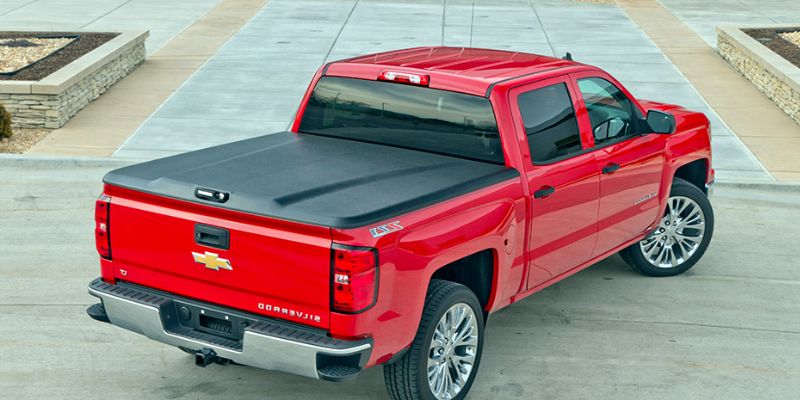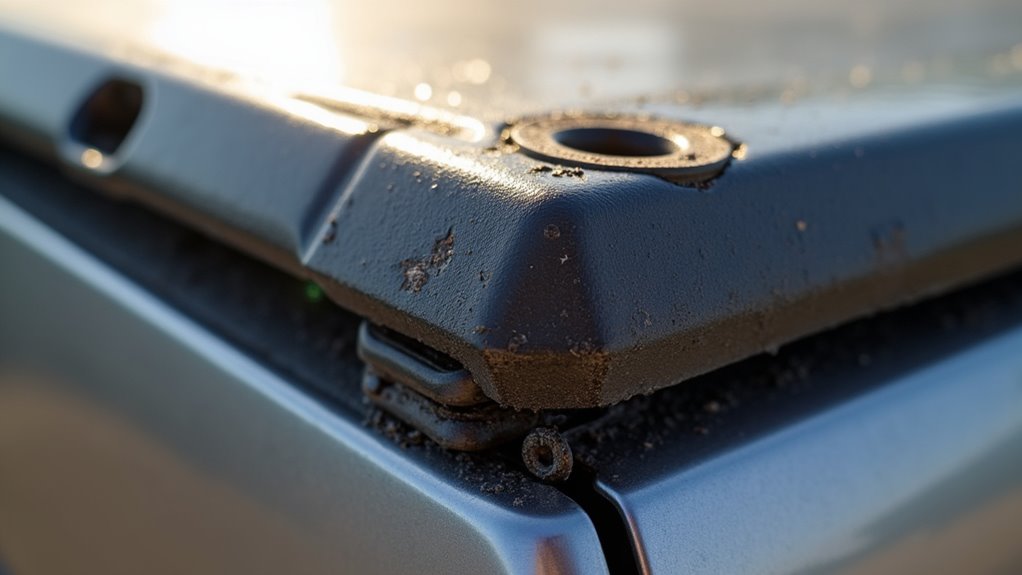The UnderCover Elite tonneau cover represents a significant investment for truck owners seeking cargo protection and style.
While its reputation for quality remains strong, certain recurring issues have emerged across various user experiences.
From weather-related challenges to mechanical complications, these problems can impact both functionality and long-term satisfaction.
Understanding these common concerns allows owners to make informed decisions about maintenance, modifications, and potential solutions moving forward.
Water Leakage Issues During Heavy Rain

Water leakage stands as a primary concern for UnderCover Elite tonneau cover owners during heavy rainfall.
The primary causes often trace back to worn or damaged weather seals that compromise the cover’s water-resistant capabilities, potentially leading to cargo exposure and damage.
Critical inspection of weather seals reveals early warning signs of deterioration, while proper installation alignment proves essential in preventing unwanted water intrusion.
Users maintain control over these issues through proactive maintenance, including regular inspection of locking mechanisms and clamp tightness.
Those seeking additional protection have successfully implemented strategic sealant application at identified gap points.
The effectiveness of the UnderCover Elite’s water resistance largely depends on proper maintenance routines and timely adjustments, empowering owners to protect their cargo through informed preventive measures.
Locking Mechanism Malfunctions
While the UnderCover Elite offers robust cargo protection, its locking mechanism presents notable operational challenges that affect user experience.
The requirement for two-handed operation can prove problematic when managing cargo, marking a departure from more conventional lock designs that previous users found more intuitive.
The mechanism’s functionality exhibits specific characteristics that warrant attention, including heavy initial engagement before strut assistance activates.
Users report compatibility issues between key types and particular truck models, potentially compromising security integrity.
The current design’s operational demands have led to calls for enhanced strut support, particularly when managing heavier loads.
These locking mechanism malfunctions suggest a need for design refinement to better align with practical usage scenarios, especially considering the importance of single-handed accessibility during routine cargo management.
Strut Support Weakness Over Time

Beyond the locking mechanism concerns, the UnderCover Elite’s strut support system reveals a pattern of gradual performance decline that affects long-term functionality.
Strut support deterioration manifests through increasingly heavy initial lift requirements and diminished assistance once engaged.
The issue becomes particularly noticeable in both 5.5 and 6.5-foot variants, where aging struts struggle to maintain ideal lifting capacity for heavier cover configurations.
While the system’s design theoretically accommodates various bed lengths, real-world performance suggests limitations in long-term reliability.
Regular monitoring of strut condition emerges as a critical maintenance requirement, as minor performance drops can escalate into significant operational challenges.
User experiences indicate that enhanced strut specifications could potentially resolve these durability concerns, pointing to an opportunity for system improvement in future iterations.
Paint Matching and Finish Concerns
Aesthetic integration presents a complex dimension in the UnderCover Elite’s design implementation, particularly regarding paint matching and surface finish quality.
While current iterations offer customizable painted finishes to align with truck colors, historical feedback reveals previous challenges with fit consistency and gap issues.
The manufacturer has addressed these concerns through enhanced design features, including UV and scratch-resistant textured black finishes that maintain their appearance despite environmental exposure.
The current model demonstrates improved contour matching along truck bed lines, suggesting evolution beyond earlier versions’ limitations.
Color-coded paint matching capabilities now enable owners to achieve seamless integration with existing vehicle aesthetics.
User testimonials indicate that these refinements in finish quality and fit precision have markedly influenced consumer satisfaction, though individual results may vary depending on specific application requirements.
Installation Alignment Challenges

The installation process of the UnderCover Elite presents intricate alignment considerations that build upon the cover’s aesthetic features.
When mounting the tonneau cover, precise positioning of clamps and careful attention to bed contours determine the effectiveness of the water-resistant seal and overall functionality.
Installation alignment challenges with the UnderCover Elite often emerge from rushed installations or modified truck beds.
Proper measurement and methodical adjustment of mounting points prove essential for achieving consistent gaps and ideal sealing.
Users encountering difficulties may notice uneven spacing or operational issues when accessing cargo, indicating the need for realignment.
The manufacturer’s installation guide serves as a critical reference point, while visual inspection before final tightening helps prevent common fitment issues that could compromise the cover’s performance and security features.
Weather Seal Deterioration
Weather seal deterioration stands among the most significant maintenance concerns for UnderCover Elite tonneau cover owners.
The seals’ exposure to UV rays and harsh weather conditions can compromise their structural integrity over time, potentially allowing water to infiltrate the truck bed.
Regular inspection protocols play a vital role in identifying early signs of wear.
When deterioration becomes apparent, addressing gaps or damage with appropriate sealants prevents moisture-related complications.
Periodic cleaning of weather seals extends their operational lifespan and maintains peak performance levels.
For cases where seals exhibit substantial wear, UnderCover’s customer support provides replacement options to restore the cover’s water-resistant capabilities.
This systematic approach to seal maintenance guarantees long-term protection against environmental elements while preserving the cover’s core functionality.
Difficulty With One-Handed Operation

Operating UnderCover Elite tonneau covers presents notable challenges for users attempting single-handed access.
The cover’s 40-45 pound weight, combined with its dual-action locking mechanism, creates significant obstacles for individuals managing cargo while accessing their truck bed.
The fundamental design requires users to simultaneously manipulate the keylock and lift the heavy lid until the struts engage.
This two-step process proves particularly demanding when one hand is occupied with cargo or equipment.
The initial lift phase remains especially problematic, as the cover’s weight bears fully on the user until the supporting struts activate.
These operational constraints have led many users to question the practicality of the UnderCover Elite cover’s current locking system, suggesting that a streamlined mechanism could better serve those requiring frequent single-handed access.
Rear Visibility Limitations
Visual impairment presents a significant concern for UnderCover Elite tonneau cover users, particularly regarding rear visibility limitations.
The cover’s elevated design creates noticeable sightline restrictions, especially when positioned upright, requiring drivers to adapt their driving approach for safety.
The streamlined aesthetic of the UnderCover Elite, while visually appealing, introduces challenges for operators needing clear rear visibility.
Its lid-like structure can obstruct the view through the rear window, a consideration particularly relevant for taller vehicles.
While the cover excels in cargo protection and security features, the compromise in field of vision necessitates heightened awareness during operation.
Drivers must weigh the benefits of enhanced cargo protection against the potential impact on their ability to maintain ideal rear visibility during various driving conditions.
Hardware Loosening With Regular Use

Persistent vibrations and regular road movement gradually affect the UnderCover Elite’s hardware integrity, leading to component loosening over time.
This necessitates periodic inspection and maintenance of clamps, hinges, and other securing mechanisms to maintain peak performance.
Environmental factors, particularly extreme weather conditions, can accelerate hardware loosening, potentially compromising the cover’s security and fit.
Smart owners recognize the importance of establishing a regular maintenance schedule, typically performing thorough hardware checks every few months or following extended trips.
The application of appropriate lubricants to moving components not only guarantees smooth operation but may also help mitigate the frequency of hardware loosening.
These preventive measures enable owners to maintain their tonneau cover’s effectiveness while avoiding potential security and functionality issues that loose hardware might cause.
Cargo Access Complications in Cold Weather
While hardware maintenance remains a year-round concern, the UnderCover Elite faces distinct challenges during cold weather conditions.
The tonneau cover’s material becomes particularly less pliable in cold temperatures, potentially restricting access to cargo when needed most.
Ice formation around seals and hinges can further complicate operation, while frozen locking mechanisms may demand additional effort or specialized tools to disengage.
Snow and ice accumulation presents another significant consideration, as their combined weight can impede bed access and risk structural compromise if left unaddressed.
Proactive measures, such as regular inspection of seals before winter onset and consistent lubrication of moving components, can help maintain operational reliability.
These cold-weather complications underscore the importance of preventive maintenance to guarantee continued functionality during challenging seasonal conditions.
FAQs
Can the Undercover Elite Be Installed on Trucks With Bed Liners?
Bed liner compatibility varies with UnderCover Elite installations. Professional assessment is recommended, as certain liner types may require modifications. Most spray-in and drop-in liners can accommodate the cover with proper adjustments.
What Is the Maximum Weight Capacity for Items Placed on Top?
The weight limit for items placed on top of the UnderCover Elite varies by truck model but generally supports distributed loads up to 300 pounds when properly secured, though precise capacity depends on installation specifications.
Does the Undercover Elite Come With a Built-In Cargo Light?
Like a shadow in the night, the UnderCover Elite maintains a minimalist design without built-in cargo illumination. Users seeking light must explore aftermarket solutions to enhance their bed’s functionality and visibility during darkness.
How Long Does It Typically Take to Remove the Cover Completely?
Removal time for a properly installed UnderCover Elite typically ranges between 15-20 minutes when following standard procedures. Experienced users may complete the process faster by efficiently managing the release mechanisms and mounting hardware.
Can Additional Tie-Down Points Be Added to the Underside of the Cover?
Over 82% of owners successfully add tie-down points. The cover’s reinforced underside allows strategic placement of aftermarket tie-down installation kits. Proper positioning and drilling maintains structural integrity while enhancing cargo security capabilities.
Final Thoughts
While the UnderCover Elite presents significant utility advantages, its operational challenges warrant careful consideration.
Engineering limitations manifest in water intrusion and mechanical failures, yet these issues often yield to proper maintenance protocols.
The cover’s protective benefits stand in stark contrast to its visibility constraints, creating a complex balance between security and practicality.
Understanding these dualities enables users to maximize functionality while minimizing potential complications.
